Effectiveness of Chitosan and Its Nanoparticles Against ampC- and ESBL-Producing Pan-Drug-Resistant Proteus mirabilis in Egyptian Livestock
Abstract
1. Introduction
2. Materials and Methods
2.1. Sample Collection and Clinical Examination
2.2. Isolation and Identification Procedures
2.3. Molecular Detection of Proteus spp. and P. mirabilis
2.4. Antimicrobial Susceptibility Testing
2.5. Detection of Antimicrobial Resistance Genes (ARGs), β-Lactamase-Encoding Genes, ampC-Encoding Gene, Colistin Resistance Gene, and Integron Integrase Gene
2.6. Chemicals Used and Preparation of Chitosan and Chitosan Nanoparticles Solution
2.7. Characterizations of CSNPs
2.7.1. Particle Size Analyzer (PSA) and Zeta Potential (ZP)
2.7.2. UV–Visible Spectroscopy
2.7.3. Fourier-Transform Infrared (FTIR) Spectroscopy
2.7.4. Transmission Electron Microscopic Observation of CSNPs
2.8. Evaluation of Antibacterial Assay of CSNPs, CS 1%, and CS 2%
2.9. Evaluation of Minimum Inhibitory Concentration (MIC) and Minimum Bactericidal Concentration (MBC)
2.10. Scanning Electron Microscopic Observation of the Antibacterial Efficacy of CS and CSNPs on Resistant P. mirabilis
2.11. Investigation of the Effect of CS and CSNPs as Anti-Swarming Agents
2.12. Statistical Analysis
3. Results
3.1. Prevalence of P. mirabilis Among Proteus spp.
3.2. Phenotypic Antimicrobial Resistance Profile of P. mirabilis Isolates
3.3. Detection of Antibiotic Resistance Genes, β-Lactamase-Encoding Genes, ampC-Encoding Genes, Carbapenemase Genes, Colistin Resistance Genes, and Integron Integrase Class 1
3.4. Detection of Association Between ESBL/ampC and qnrA-, mcr-1-, dfrA1-, aadA1-, sul2-, catA1-, tet(M)-, and ermB-Encoding Resistance Genes
3.5. Correlation and Concordance Between Genetic Determinants and Phenotypic Resistance Profiles
3.6. Identification and Characterization of the Prepared CSNPs
3.7. Antibacterial Efficacy of CS and CSNPs on P. mirabilis
3.8. Determination of MIC and MBC of CS 1%, CS 2%, and CSNPs Against Resistant P. mirabilis
3.9. Scanning Electron Microscopy of P. mirabilis
3.10. The Impact of CS and CSNPs on Swarming Motility
4. Discussion
5. Conclusions
6. Study Limitations and Future Directions
Supplementary Materials
Author Contributions
Funding
Institutional Review Board Statement
Informed Consent Statement
Data Availability Statement
Acknowledgments
Conflicts of Interest
References
- Najim, H.T.; Farhan, A.A.; Athab, A.M. Bacteriological Study of the Bacteria Cause Urinary Tract Infection of Patients Admitted to Cardiac Care Unite a Baqubah General Teaching Hospital. Diyala J. Med. 2018, 14, 73–83. [Google Scholar] [CrossRef]
- Saif, Y.M. Diseases of Poultry. In Other Bacterial Diseases, 12th ed.; Blackwell Publishing Professional: Ames, IA, USA, 2008; pp. 959–961. [Google Scholar]
- Sanches, M.S.; Baptista, A.A.S.; de Souza, M.; Menck-Costa, M.F.; Justino, L.; Nishio, E.K.; Rocha, S.P.D. Proteus mirabilis causing cellulitis in broiler chickens. Braz. J. Microbiol. 2020, 51, 1353–1362. [Google Scholar] [CrossRef]
- Schaffer, J.N.; Pearson, M.M. Proteus mirabilis and urinary tract infections. In Urinary Tract Infections: Molecular Pathogenesis and Clinical Management; ASM Press: Washington, DC, USA, 2017; pp. 383–433. [Google Scholar]
- Sanches, M.S.; Baptista, A.A.S.; de Souza, M.; Menck-Costa, M.F.; Koga, V.L.; Kobayashi, R.K.T.; Rocha, S.P.D. Genotypic and phenotypic profiles of virulence factors and antimicrobial resistance of Proteus mirabilis isolated from chicken carcasses: Potential zoonotic risk. Braz. J. Microbiol. 2019, 50, 685–694. [Google Scholar] [CrossRef]
- Chen, L.; Zhang, Y.; Du, J.; Zhang, X.; Li, M.; Chen, H. Description and plasmid characterization of the qnrD determinant in Proteeae in Wenzhou, Southern China. J. Microbiol. Immunol. Infect. 2018, 51, 115–122. [Google Scholar] [CrossRef] [PubMed]
- Aygül, A.; Öztürk, İ.; Çilli, F.F.; Ermertcan, Ş. Quercetin inhibits swarming motility and activates biofilm production of Proteus mirabilis possibly by interacting with central regulators, metabolic status or active pump proteins. Phytomedicine 2019, 57, 65–71. [Google Scholar] [CrossRef] [PubMed]
- Bloch, J.; Lemaire, X.; Legout, L.; Ferrby, D.; Yazdanpanah, Y.; Senneville, E. Brain abscesses during Proteus vulgaris bacteremia. Neurol. Sci. 2011, 32, 661–663. [Google Scholar] [CrossRef]
- Chakkour, M.; Hammoud, Z.; Farhat, S.; El Roz, A.; Ezzeddine, Z.; Ghssein, G. Overview of Proteus mirabilis pathogenicity and virulence. Insights into the role of metals. Front. Microbiol. 2024, 15, 1383618. [Google Scholar] [CrossRef] [PubMed]
- Zhang, J.; Hoedt, E.C.; Liu, Q.; Berendsen, E.; The, J.J.; Hamilton, A. Elucidation of Proteus mirabilis as a key bacterium in Crohn’s disease inflammation. Gastroenterology 2021, 160, 317–330. [Google Scholar] [CrossRef]
- Chen, S.L.; Kang, Y.T.; Liang, Y.H.; Qiu, X.T.; Li, Z.J. A core genome multilocus sequence typing scheme for Proteus mirabilis. Biomed. Environ. Sci. 2023, 36, 343–352. [Google Scholar]
- Kearns, D.B.; Losick, R. Swarming motility in undomesticated Bacillus subtilis. Mol. Microbiol. 2003, 49, 581–590. [Google Scholar] [CrossRef]
- Rather, P.N. Swarmer cell differentiation in Proteus mirabilis. Environ. Microbiol. 2005, 7, 1065–1073. [Google Scholar] [CrossRef]
- Magiorakos, A.P.; Srinivasan, A.; Carey, R.B.; Carmeli, Y.; Falagas, M.E.; Giske, C.G.; Harbarth, S.; Hindler, J.F.; Kahlmeter, G.; Olsson-Liljequist, B.; et al. Multidrug-resistant, extensively drug-resistant and pandrug-resistant bacteria: An international expert proposal for interim standard definitions for acquired resistance. Clin. Microbiol. Infect. 2012, 18, 268–281. [Google Scholar] [CrossRef]
- OECD. Stemming the Superbug Tide Just a Few Dollars More; Organisation for Economic Co-Operation and Development: Paris, France, 2018. [Google Scholar] [CrossRef]
- Al-Saadi, N.; Alsallami, D.; Alsultan, A.; Al-hriahaw, H. Whole-genomic sequence of multidrug resistance burkholderia cepacia associated with acute suppurative thyroiditis. J. Complement. Med. Res. 2022, 13, 50–52. [Google Scholar] [CrossRef]
- Girlich, D.; Bonnin, R.A.; Dortet, L.; Naas, T. Genetics of acquired antibiotic resistance genes in Proteus spp. Front. Microbiol. 2020, 11, 256. [Google Scholar]
- Pitout, J.D.; Nordmann, P.; Laupland, K.B.; Poirel, L. Emergence of Enterobacteriaceae producing extended-spectrum β-lactamases (ESBLs) in the community. J. Antimicrob. Chemother. 2005, 56, 52–59. [Google Scholar] [CrossRef] [PubMed]
- Lim, E.J.; Ho, S.X.; Cao, D.Y.; Lau, Q.C.; Koh, T.H.; Hsu, L.Y. Extended-Spectrum Beta-Lactamase-Producingin Retail Chicken Meat in Singapore. Ann. Acad. Med. Singap. 2016, 45, 557–559. [Google Scholar] [CrossRef]
- Bush, K.; Jacoby, G.A. Updated functional classification of β-lactamases. Antimicrob. Agents Chemother. 2010, 54, 969–976. [Google Scholar] [CrossRef]
- Shaaban, M.; Elshaer, S.L.; Abd El-Rahman, O.A. Prevalence of extended-spectrum β-lactamases, AmpC, and carbapenemases in Proteus mirabilis clinical isolates. BMC Microbiol. 2022, 22, 247. [Google Scholar] [CrossRef]
- Rao, M.J.; Harle, S.; Padmavathy, M. Prevalence of extended spectrum beta-lactamases and amp-c beta-lactamases in clinical isolates of gram-negative bacilli at a tertiary care hospital. J. Evol. Med. Dent. Sci. 2018, 7, 5072–5077. [Google Scholar]
- Bratu, S.; Landman, D.; Haag, R.; Recco, R.; Eramo, A.; Alam, M.; Quale, J. Rapid spread of carbapenem-resista Bush nt Klebsiella pneumoniae in New York City: A new threat to our antibiotic armamentarium. Arch. Intern. Med. 2005, 165, 1430–1435. [Google Scholar] [CrossRef]
- Brink, A.J.; Coetzee, J.; Clay, C.G.; Sithole, S.; Richards, G.A.; Poirel, L.; Nordmann, P. Emergence of New Delhi metallo-beta-lactamase (NDM-1) and Klebsiella pneumoniae carbapenemase (KPC-2) in South Africa. J. Clin. Microbiol. 2012, 50, 525–527. [Google Scholar] [CrossRef]
- Queenan, A.M.; Bush, K. Carbapenemases: The versatile β-lactamases. Clin. Microbiol. Rev. 2007, 20, 440–458. [Google Scholar] [CrossRef]
- Nordmann, P.; Naas, T.; Poirel, L. Global spread of carbapenemase-producing Enterobacteriaceae. Emerg. Infect. Dis. 2011, 17, 1791. [Google Scholar] [CrossRef]
- Hughes, D.; Andersson, D.I. Environmental and genetic modulation of the phenotypic expression of antibiotic resistance. FEMS Microbiol. Rev. 2017, 41, 374–391. [Google Scholar] [CrossRef]
- Hu, R.; Wang, X.; Muhamamd, I.; Wang, Y.; Dong, W.; Zhang, H. Biological characteristics and genetic analysis of a highly pathogenic Proteus mirabilis strain isolated from dogs in China. Front. Vet. Sci. 2020, 7, 589. [Google Scholar] [CrossRef] [PubMed]
- Leverstein-van Hall, M.A.; MBlok, H.E.; TDonders, A.R.; Paauw, A.; Fluit, A.C.; Verhoef, J. Multidrug resistance among Enterobacteriaceae is strongly associated with the presence of integrons and is independent of species or isolate origin. J. Infect. Dis. 2003, 187, 251–259. [Google Scholar] [CrossRef] [PubMed]
- Liu, J.H.; Liu, Y.Y.; Shen, Y.B.; Yang, J.; Walsh, T.R.; Wang, Y.; Shen, J. Plasmid-mediated colistin-resistance genes: Mcr. Trends Microbiol. 2024, 32, 365–378. [Google Scholar] [CrossRef] [PubMed]
- Wang, R.; Van Dorp, L.; Shaw, L.P.; Bradley, P.; Wang, Q.; Wang, X. The global distribution and spread of the mobilized colistin resistance gene mcr-1. Nat. Commun. 2018, 9, 1179. [Google Scholar] [CrossRef]
- Al-Kadmy, I.M.; Ibrahim, S.A.; Al-Saryi, N.; Aziz, S.N.; Besinis, A.; Hetta, H.F. Prevalence of genes involved in colistin resistance in Acinetobacter baumannii: First report from Iraq. Microb. Drug Resist. 2020, 26, 616–622. [Google Scholar] [CrossRef]
- Said, H.S.; Abdelmegeed, E.S. Emergence of multidrug resistance and extensive drug resistance among enterococcal clinical isolates in Egypt. Infect. Drug Resist. 2019, 12, 1113–1125. [Google Scholar] [CrossRef]
- Cai, J.; Yang, T.; Chen, H.; Bai, Y. Advances in the application of bacteriophage in the inhibiting of bacteria. Heilongjiang Anim. Sci. Vet. Med. 2021, 15, 40–46. [Google Scholar]
- Dedloff, M.R.; Effler, C.S.; Holban, A.M.; Gestal, M.C. Use of biopolymers in mucosally-administered vaccinations for respiratory disease. Materials 2019, 12, 2445. [Google Scholar] [CrossRef] [PubMed]
- Shoueir, K.R.; El-Desouky, N.; Rashad, M.M.; Ahmed, M.K.; Janowska, I.; El-Kemary, M. Chitosan based-nanoparticles and nanocapsules: Overview, physicochemical features, applications of a nanofibrous scaffold, and bioprinting. Int. J. Biol. Macromol. 2021, 167, 1176–1197. [Google Scholar] [CrossRef] [PubMed]
- Li, J.; Zhuang, S. Antibacterial activity of chitosan and its derivatives and their interaction mechanism with bacteria: Current state and perspectives. Eur. Polym. J. 2020, 138, 109984. [Google Scholar] [CrossRef]
- Dutta, P.K.; Tripathi, S.; Mehrotra, G.K.; Dutta, J. Perspectives for chitosan based antimicrobial films in food applications. Food Chem. 2009, 114, 1173–1182. [Google Scholar] [CrossRef]
- Ishaq, K.; Ahmad, A.; Rafique, A.; Aslam, R.; Ali, S.; Shahid, M.A.; Sarwar, N.; Aslam, M.A.; Aslam, B.; Arshad, M.I. Occurrence and antimicrobial susceptibility of Proteus mirabilis from chicken carcass. Pak. Vet. J. 2022, 42, 576–579. [Google Scholar] [CrossRef]
- Markey, B.; Leonard, F.; Archambault, M.; Cullinane, A.; Maguire, D. Clinical Veterinary Microbiology, 2nd ed.; Mosby Elsevier Health Sciences: Dublin, Ireland, 2013; pp. 239–274. [Google Scholar]
- Zahraei, S.M.; Rabani, K.M.; Safarchi, A.; Peyghambari, S.M.; Mahzounieh, M. Detection of stx1, stx2, eae, espB and hly genes in avian pathogenic Escherichia coli by multiplex polymerase chain reaction. J. Vet. Res. 2007, 62, 37–42. [Google Scholar]
- Kadhim AL-Imam, M.J.; AL-Rubaii, B.A.L. The influence of some amino acids, vitamins and anti-inflammatory drugs on activity of chondroitinase produced by Proteus vulgaris caused urinary tract infection. Iraqi J. Sci. 2016, 57, 2412–2421. [Google Scholar]
- Al-Mudallal, N.H.; Khudair, A.M.; Abdoul Hadi Alsakini, A.H.; Zidane, N.A. Molecular detection and phylogenetic analysis of 16s RNA gene of Proteus mirabilis isolated from different clinical sources in Baghdad hospitals. Biochem. Cell Arch. 2021, 21, 2. [Google Scholar]
- CLSI. Performance standards for antimicrobial disk susceptibility testing. In CLSI Supplement M100, 34th ed.; Malvern, P.A., Ed.; Clinical and Laboratory Standards Institute: Berwyn, PA, USA, 2024. [Google Scholar]
- Decôme, M.; Cuq, B.; Fairbrother, J.H.; Gatel, L.; Conversy, B. Clinical significance of Proteus mirabilis bacteriuria in dogs, risk factors and antimicrobial susceptibility. Can. J. Vet. Res. 2020, 84, 252–258. [Google Scholar]
- World Health Organization. Critically Important Antimicrobials for Human Medicine: Ranking of Antimicrobial Agents for Risk Management of Antimicrobial Resistance Due to Non-Human Use; World Health Organization: Geneva, Switzerland, 2017. [Google Scholar]
- Archambault, M.; Petrov, P.; Hendriksen, R.S.; Asseva, G.; Bangtrakulnonth, A.; Hasman, H.; Aarestrup, F.M. Molecular characterization and occurrence of extended-spectrum β-lactamase resistance genes among Salmonella enterica serovar Corvallis from Thailand, Bulgaria, and Denmark. Microb. Drug Resist. 2006, 12, 192–198. [Google Scholar] [CrossRef]
- Colom, K.; Pérez, J.; Alonso, R.; Fernández-Aranguiz, A.; Lariño, E.; Cisterna, R. Simple and reliable multiplex PCR assay for detection of bla TEM, bla SHV and bla OXA–1 genes in Enterobacteriaceae. FEMS Microbiol. Lett. 2003, 223, 147–151. [Google Scholar] [CrossRef]
- Mirsalehian, A.; Feizabadi, M.; Nakhjavani, F.A.; Jabalameli, F.; Goli, H.; Kalantari, N. Detection of VEB-1, OXA-10 and PER-1 genotypes in extended-spectrum β-lactamase-producing Pseudomonas aeruginosa strains isolated from burn patients. Burns 2010, 36, 70–74. [Google Scholar] [CrossRef] [PubMed]
- Kim, J.; Jeon, S.; Rhie, H.; Lee, B.; Park, M.; Lee, H. Rapid detection of extended spectrum β-lactamase (ESBL) for Enterobacteriaceae by use of a multiplex PCR-based method. Infect. Chemother. 2009, 41, 181–184. [Google Scholar] [CrossRef]
- Randall, L.P.; Cooles, S.W.; Osborn, M.K.; Piddock, L.J.V.; Woodward, M.J. Antibiotic resistance genes, integrons and multiple antibiotic resistance in thirty-five serotypes of Salmonella enterica isolated from humans and animals in the UK. J. Antimicrob. Chemother. 2004, 53, 208–216. [Google Scholar] [CrossRef]
- Van, T.T.H.; Chin, J.; Chapman, T.; Tran, L.T.; Coloe, P.J. Safety of raw meat and shellfish in Vietnam: An analysis of Escherichia coli isolations for antibiotic resistance and virulence genes. Int. J. Food Microbiol. 2008, 124, 217–223. [Google Scholar] [CrossRef] [PubMed]
- Robicsek, A.; Strahilevitz, J.; Sahm, D.F.; Jacoby, G.A.; Hooper, D.C. qnr prevalence in ceftazidime-resistant Enterobacteriaceae isolates from the United States. Antimicrob. Agents Chemother. 2006, 50, 2872–2874. [Google Scholar] [CrossRef] [PubMed]
- López, M.; Tenorio, C.; Del Campo, R.; Zarazaga, M.; Torres, C. Characterization of the mechanisms of fluoroquinolone resistance in vancomycin-resistant enterococci of different origins. J. Chemother. 2011, 23, 87–91. [Google Scholar] [CrossRef]
- Godreuil, S.; Galimand, M.; Gerbaud, G.; Jacquet, C.; Courvalin, P. Efflux pump Lde is associated with fluoroquinolone resistance in Listeria monocytogenes. Antimicrob. Agents Chemother. 2003, 47, 704–708. [Google Scholar] [CrossRef]
- Poppe, C.; Martin, L.; Muckle, A.; Archambault, M.; McEwen, S.; Weir, E. Characterization of antimicrobial resistance of Salmonella Newport isolated from animals, the environment, and animal food products in Canada. Can. J. Vet. Res. 2006, 70, 105. [Google Scholar]
- Toro, C.S.; Farfán, M.; Contreras, I.; Flores, O.; Navarro, N.; Mora, G.C.; Prado, V. Genetic analysis of antibiotic-resistance determinants in multidrug-resistant Shigella strains isolated from Chilean children. Epidemiol. Infect. 2005, 133, 81–86. [Google Scholar] [CrossRef] [PubMed]
- Warsa, U.C.; Nonoyama, M.; Ida, T.; Okamoto, R.; Okubo, T.; Shimauchi, C.; Kuga, A.; Inoue, M. Detection of tet(K) and tet(M) in Staphylococcus aureus of Asian countries by the polymerase chain reaction. J. Antibiot. 1996, 49, 1127–1132. [Google Scholar] [CrossRef]
- Flórez, A.B.; Alegría, Á.; Rossi, F.; Delgado, S.; Felis, G.E.; Torriani, S.; Mayo, B. Molecular identification and quantification of tetracycline and erythromycin resistance genes in Spanish and Italian retail cheeses. Biomed. Res. Int. 2014, 2014, 746859. [Google Scholar] [CrossRef]
- Morvan, A.; Moubareck, C.; Leclercq, A.; Hervé-Bazin, M.; Bremont, S.; Lecuit, M.; Courvalin, P.; Monnier, A. Antimicrobial resistance of Listeria monocytogenes strains isolated from humans in France. Antimicrob. Agents Chemother. 2010, 54, 2728–2731. [Google Scholar] [CrossRef] [PubMed]
- Levesque, C.; Piche, L.; Larose, C.; Roy, P.H. PCR mapping of integrons reveals several novel combinations of resistance genes. Antimicrob. Agents Chemother. 1995, 39, 185–191. [Google Scholar] [CrossRef] [PubMed]
- Liu, P.; Chen, S.; Wu, Z.Y.; Qi, M.; Li, X.Y.; Liu, C.X. Mechanisms of fosfomycin resistance in clinical isolates of carbapenem-resistant Klebsiella pneumoniae. J. Glob. Antimicrob. Resist. 2020, 22, 238–243. [Google Scholar] [CrossRef]
- Liu, Y.-Y.; Wang, Y.; Walsh, T.R.; Yi, L.-X.; Zhang, R.; Spencer, J.; Doi, Y.; Tian, G.; Dong, B.; Huang, X.; et al. Emergence of plasmid-mediated colistin resistance mechanism MCR-1 in animals and human beings in China: A microbiological and molecular biological study. Lancet Infect. Dis. 2016, 16, 161–168. [Google Scholar] [CrossRef]
- Dallenne, C.; Da Costa, A.; Decre, D.; Favier, C.; Arlet, G. Development of a set of multiplex PCR assays for the detection of genes encoding important B-lactmases in Enterobacteriaceae. J. Antimicrobe Chemother. 2010, 65, 490–495. [Google Scholar] [CrossRef]
- Hou, M.; Chen, N.; Dong, L.; Fang, Y.; Pan, R.; Wang, W.; Wang, L.; Ning, J.; Dong, H. Molecular epidemiology, clinical characteristics and risk factors for bloodstream infection of multidrug-resistant Klebsiella pneumoniae infections in pediatric patients from Tianjin, China. Infect. Drug Resist. 2022, 15, 7015–7023. [Google Scholar] [CrossRef]
- Sjölander, I.; Hansen, F.; Elmanama, A.; Khayyat, R.; Abu-Zant, A.; Hussein, A.; Taha, A.A.; Hammerum, A.M.; Ciofu, O. Detection of NDM-2-producing Acinetobacter baumannii and VIM-producing Pseudomonas aeruginosa in Palestine. J. Glob. Antimicrobe Resist. 2014, 2, 93–97. [Google Scholar] [CrossRef]
- Xia, C.; Yan, R.; Liu, C.; Zhai, J.; Zheng, J.; Chen, W.; Cao, X. Epidemiological and genomic characteristics of global bla NDM-carrying Escherichia coli. Ann. Clin. Microbiol. Antimicrob. 2024, 23, 58. [Google Scholar] [CrossRef]
- Muller, R.; Mader, K.; Gohla, S. Solid lipid nanoparticles (SLN) for controlled drug delivery—A review of the state of the Art. Eur. J. Pharm. Biopharm. 2000, 50, 161–177. [Google Scholar] [CrossRef] [PubMed]
- Fasihnia, S.H.; Peighambardoust, S.H.; Peighambardoust, S.J.; Oromiehie, A.; Soltanzadeh, M.; Peressini, D. Migration analysis, antioxidant, and mechanical characterization of polypropylene-based active food packaging films loaded with BHA, BHT, and TBHQ. J. Food Sci. 2020, 85, 2317–2328. [Google Scholar] [CrossRef] [PubMed]
- Ali, N.G.; Ali, T.E.S.; Kamel, M.F.; Saleh, R.; Sherif, A.H.; Aboyadak, I.M. Eradication of Livoneca redmanii infestation in cultured Argycrosomus regius. Aquaculture 2022, 558, 738373. [Google Scholar] [CrossRef]
- EUCASTT. European Committee for Antimicrobial Susceptibility Testing of the European Society of Clinical Microbiology and Infectious Diseases (ESCMID). Determination of minimum inhibitory concentrations (MICs) of antibacterial agents by agar dilution. Clin. Microbiol. Infect. 2000, 6, 509–515. [Google Scholar] [CrossRef] [PubMed]
- Elshikh, M.; Ahmed, S.; Funston, S.; Dunlop, P.; McGaw, M.; Marchant, R.; Banat, I.M. Resazurin-based 96-well plate microdilution method for the determination of minimum inhibitory concentration of biosurfactants. Biotechnol. Lett. 2016, 38, 1015–1019. [Google Scholar] [CrossRef]
- Diao, Y.; Yu, X.; Zhang, C.; Jing, Y. Quercetin-grafted chitosan prepared by free radical grafting: Characterization and evaluation of antioxidant and antibacterial properties. J. Food Sci. Technol. 2020, 57, 2259–2268. [Google Scholar] [CrossRef]
- Abedian, Z.; Jenabian, N.; Moghadamnia, A.A.; Zabihi, E.; Tashakorian, H.; Rajabnia, M.; Sadighian, F.; Bijani, A. Antibacterial activity of high-molecular-weight and low-molecular-weight chitosan upon oral pathogens. J. Conserv. Dent. 2019, 22, 169–174. [Google Scholar] [CrossRef]
- Qi, L.; Xu, Z.; Jiang, X.; Hu, C.; Zou, X. Preparation and antibacterial activity of chitosan nanoparticles. Carbohydr. Res. 2004, 339, 2693–2700. [Google Scholar] [CrossRef]
- French, G.L. Bactericidal agents in the treatment of MRSA infections—The potential role of daptomycin. J. Antimicrob. Chemother. 2006, 58, 1107–1117. [Google Scholar] [CrossRef]
- Jeong, Y.; Lim, D.W.; Choi, J. Assessment of size-dependent antimicrobial and cytotoxic properties of silver nanoparticles. Adv. Mater. Sci. Eng. 2014, 1, 763807. [Google Scholar] [CrossRef]
- Nahar, A.; Siddiquee, M.; Nahar, S.; Anwar, K.S.; Islam, S. Multidrug resistant-Proteus mirabilis isolated from chicken droppings in commercial poultry farms: Bio-security concern and emerging public health threat in Bangladesh. J. Biosaf. Health Educ. 2014, 2, 120. [Google Scholar] [CrossRef]
- El-Demerdash, A.S.; Aggour, M.G.; El-Azzouny, M.M.; Abou-Khadra, S.H. Molecular analysis of integron gene cassette arrays associated multi-drug resistant Enterobacteriaceae isolates from poultry. Cell Mol. Biol. 2018, 64, 149–156. [Google Scholar] [CrossRef] [PubMed]
- Zhu, X.; Zhang, Y.; Shen, Z.; Xia, L.; Wang, J.; Zhao, L.; Wang, K.; Wang, W.; Hao, Z.; Liu, Z. Characterization of NDM-1-producing carbapenemase in Proteus mirabilis among broilers in China. Microorganisms 2021, 9, 2443. [Google Scholar] [CrossRef]
- Koirala, B.; Bhattarai, R.; Maharjan, R.; Maharjan, S.; Shrestha, S. Bacterial Assessment of Buffalo Meat in Kathmandu Valley. Nepal J. Sci. Technol. 2020, 19, 90–96. [Google Scholar] [CrossRef]
- Mansour, S.N.; Youssef, W.; Hana, Y.; Elias, R.S.; Nagib, H.E.; Hakim, A.S.; Younis, E.M.; Dapgh, A.N. Multidrug Resistance in Gram Negative Bacteria Isolated from Cases of Mastitis in Buffaloes. Egypt. J. Anim. Health 2023, 3, 169–183. [Google Scholar]
- Mirzaei, A.; Habibi, M.; Bouzari, S.; Asadi Karam, M.R. Characterization of antibiotic-susceptibility patterns, virulence factor profiles and clonal relatedness in Proteus mirabilis isolates from patients with urinary tract infection in Iran. Infect. Drug Resist. 2019, 12, 3967–3979. [Google Scholar] [CrossRef] [PubMed]
- Li, Z.; Peng, C.; Zhang, G.; Shen, Y.; Zhang, Y.; Liu, C.; Liu, M.; Wang, F. Prevalence and characteristics of multidrug-resistant Proteus mirabilis from broiler farms in Shandong Province, China. Poult. Sci. 2022, 101, 101710. [Google Scholar] [CrossRef]
- Ramatla, T.; Ramaili, T.; Lekota, K.; Mileng, K.; Ndou, R.; Mphuthi, M.; Khasapane, N.; Syakalima, M.; Thekisoe, O. Antibiotic resistance and virulence profiles of Proteus mirabilis isolated from broiler chickens at abattoir in South Africa. Vet. Med. Sci. 2024, 10, e1371. [Google Scholar] [CrossRef]
- El-Saeed, B.A.; Elshebrawy, H.A.; Zakaria, A.I.; Abdelkhalek, A.; Imre, K.; Morar, A.; Herman, V.; Sallam, K.I. Multidrug-resistant Proteus mirabilis and other gram-negative species isolated from native Egyptian chicken carcasses. Trop. Med. Infect. Dis. 2024, 9, 217. [Google Scholar] [CrossRef]
- Ma, S.; Shen, J.; Xu, Y.; Ding, P.; Gao, X.; Pan, Y.; Wu, H.; Hu, G.; He, D. Epidemic characteristics of the SXT/R391 integrated conjugative elements in multidrug-resistant Proteus mirabilis isolated from chicken farm. Poult. Sci. 2023, 102, 102640. [Google Scholar] [CrossRef]
- Yu, Z.; Joossens, M.; Van den Abeele, A.M.; Kerkhof, P.J.; Houf, K. Isolation, characterization and antibiotic resistance of Proteus mirabilis from Belgian broiler carcasses at retail and human stool. Food Microbiol. 2021, 96, 103724. [Google Scholar] [CrossRef] [PubMed]
- Sanches, M.S.; Silva, L.C.; Silva, C.R.D.; Montini, V.H.; Oliva, B.H.D.d.; Guidone, G.H.M.; Nogueira, M.C.L.; Menck-Costa, M.F.; Kobayashi, R.K.T.; Vespero, E.C.; et al. Prevalence of Antimicrobial Resistance and Clonal Relationship in ESBL/AmpC-Producing Proteus mirabilis isolated from Meat products and Community-acquired urinary tract infection (UTI-CA) in Southern Brazil. Antibiotics 2023, 12, 370. [Google Scholar] [CrossRef]
- Sun, Y.; Wen, S.; Zhao, L.; Xia, Q.; Pan, Y.; Liu, H.; Wei, C.; Chen, H.; Ge, J.; Wang, H. Association among biofilm formation, virulence gene expression, and antibiotic resistance in Proteus mirabilis isolates from diarrhetic animals in Northeast China. BMC Vet. Res. 2020, 16, 176. [Google Scholar] [CrossRef] [PubMed]
- Ma, W.Q.; Han, Y.Y.; Zhou, L.; Peng, W.Q.; Mao, L.Y.; Yang, X.; Wang, Q.; Zhang, T.J.; Wang, H.N.; Lei, C.W. Contamination of Proteus mirabilis harbouring various clinically important antimicrobial resistance genes in retail meat and aquatic products from food markets in China. Front. Microbiol. 2022, 13, 1086800. [Google Scholar] [CrossRef]
- Ram, V.P.; Rao, L.V.; Rao, T.S.; Subramanyam, K.V.; Suresh, Y.; Srinivas, K. A Study on Antibiogram and Beta-lactam Resistance of Proteus mirabilis Isolated from Animals and Humans in Andhra Pradesh, India. Indian J. Anim. Res. 2022, 56, 607–612. [Google Scholar] [CrossRef]
- von Tippelskirch, P.; Gölz, G.; Projahn, M.; Daehre, K.; Friese, A.; Roesler, U.; Alter, T.; Orquera, S. Prevalence and quantitative analysis of ESBL and AmpC beta-lactamase producing Enterobacteriaceae in broiler chicken during slaughter in Germany. Int. J. Food Microbiol. 2018, 281, 82–89. [Google Scholar] [CrossRef] [PubMed]
- Hu, H.; Wu, K.; Zhang, T.; Mou, Y.; Liu, L.; Wang, X.; Xu, W.; Chen, W.; Chen, X.; Wang, H.; et al. Whole Genome Analysis of Proteus mirabilis in a Poultry Breeder Farm Reveals the Dissemination of bla NDM and bla CTX-M Mediated by Diverse Mobile Genetic Elements. Agriculture 2025, 15, 555. [Google Scholar] [CrossRef]
- Gür, D. General Characteristics of ESBLs and ESBL Types, New and Reemerging Infections (ESBL’lerin Genel Özellikleri ve ESBL Tipleri, Yeni ve Yeniden Gündeme Gelen Infeksiyonlar In Turkish); Bilimsel Tıp Yayınevi: Ankara, Turkey, 2004; pp. 5–13. [Google Scholar]
- Almeida, H.F.D.; Trindade, P.R.C.M.; Teixeira, C.R.V.; Brito, C.O.; Dolabella, S.S.; Jain, S.; Martins, M.P.; Barbosa, A.A.T. Antibiotic resistance gene occurrence in poultry farms in northeast Brazil. Ciênc. Anim. Bras. 2025, 26, 79298E. [Google Scholar] [CrossRef]
- Sarwar, A.; Aslam, B.; Mahmood, S.; Muzammil, S.; Siddique, A.B.; Sarwar, F.; Khurshid, M.; Rasool, M.H.; Sasanya, J.; Aljasir, S.F. Distribution of multidrug-resistant Proteus mirabilis in poultry, livestock, fish, and the related environment: One Health heed. Vet. World 2025, 18, 446. [Google Scholar] [CrossRef]
- Ejaz, H.; Younas, S.; Abosalif, K.O.; Junaid, K.; Alzahrani, B.; Alsrhani, A.; Abdalla, A.E.; Ullah, M.I.; Qamar, M.U.; Hamam, S.S.M. Molecular analysis of blaSHV, blaTEM, and blaCTX-M in extended-spectrum β-lactamase producing Enterobacteriaceae recovered from fecal specimens of animals. PLoS ONE 2021, 16, e0245126. [Google Scholar] [CrossRef] [PubMed]
- Ogefere, H.O.; Osikobia, J.G.; Omoregie, R. Prevalence of AmpC β-lactamase among Gram-negative bacteria recovered from clinical specimens in Benin City, Nigeria. Trop. J. Pharm. Res. 2016, 15, 1947–1953. [Google Scholar] [CrossRef]
- Girlich, D.; Bonnin, R.A.; Bogaerts, P.; De Laveleye, M.; Huang, D.T.; Dortet, L.; Glaser, P.; Glupczynski, Y.; Naas, T. Chromosomal amplification of the blaOXA-58 carbapenemase gene in a Proteus mirabilis clinical isolate. Antimicrob. Agents Chemother. 2017, 61, e01697-16. [Google Scholar] [CrossRef]
- Mushi, M.F.; Mshana, S.E.; Imirzalioglu, C.; Bwanga, F. Carbapenemase genes among multidrug resistant gram-negative clinical isolates from a tertiary hospital in Mwanza, Tanzania. Biomed. Res. Int. 2014, 1, 303104. [Google Scholar] [CrossRef]
- ElTaweel, M.; Said, H.S.; Barwa, R. Emergence of extensive drug resistance and high prevalence of multidrug resistance among clinical Proteus mirabilis isolates in Egypt. Ann. Clin. Microbiol. Antimicrob. 2024, 23, 46. [Google Scholar] [CrossRef]
- Moawad, A.A.; Hotzel, H.; Neubauer, H.; Ehricht, R.; Monecke, S.; Tomaso, H.; Hafez, H.M.; Roesler, U.; El-Adawy, H. Antimicrobial resistance in Enterobacteriaceae from healthy broilers in Egypt: Emergence of colistin-resistant and extended-spectrum beta-lactamase-producing Escherichia coli. Gut Pathog. 2018, 10, 39. [Google Scholar] [CrossRef]
- Saiprasad, P.V.; Krishnaprasad, K. Exploring the hidden potential of fosfomycin for the fight against severe Gram-negative infections. Indian J. Med. Microbiol. 2016, 34, 416–420. [Google Scholar] [CrossRef]
- World Health Organization. WHO Advisory Group on Integrated Surveillance of Antimicrobial Resistance (AGISAR). Critically important antimicrobials for human medicine 3rd Revision 2011. WHO Document Production Services, Geneva, Switzerland. Clin. Infect. Dis. 2012, 55, 712–719. [Google Scholar]
- Lalezadeh, A.; Ghotaslou, P.; Ghotaslou, R. The Detection of Fosfomycin-Modifying Enzymes (fos) in Uropathogenic Enterobacterale, Azerbaijan, Iran. Can. J. Infect. Dis. Med. Microbiol. 2023, 2023, 3766269. [Google Scholar] [CrossRef] [PubMed]
- Tewari, R.; Mitra, S.; Venugopal, N.; Das, S.; Ganaie, F.; Sen, A.; Shome, R.; Rahman, H.; Shome, B.R. Phenotypic and molecular characterization of extended spectrum β-lactamase, ampc β-lactamase and metallo β-lactamase producing Klebsiella spp. from farm animals in India. Indian J. Anim. Res. 2019, 53, 938–943. [Google Scholar]
- Algammal, A.M.; Hashem, H.R.; Alfifi, K.J.; Hetta, H.F.; Sheraba, N.S.; Ramadan, H.; El-Tarabili, R.M. atpD gene sequencing, multidrug resistance traits, virulence-determinants, and antimicrobial resistance genes of emerging XDR and MDR-Proteus mirabilis. Sci. Rep. 2021, 11, 9476. [Google Scholar] [CrossRef]
- Singh, S.; Yadav, A.S.; Singh, S.M.; Bharti, P. Prevalence of Salmonella in chicken eggs collected from poultry farms and marketing channels and their antimicrobial resistance. Food Res. Int. 2010, 43, 2027–2030. [Google Scholar] [CrossRef]
- Little, K.; Austerman, J.; Zheng, J.; Gibbs, K.A. Cell shape and population migration are distinct steps of Proteus mirabilis swarming that are decoupled on high-percentage agar. J. Bacteriol. 2019, 201, 10–1128. [Google Scholar] [CrossRef] [PubMed]
- Vaezifar, S.; Razavi, S.; Golozar, M.A.; Karbasi, S.; Morshed, M.; Kamali, M. Effects of some parameters on particle size distribution of chitosan nanoparticles prepared by ionic gelation method. J. Clust. Sci. 2013, 24, 891–903. [Google Scholar] [CrossRef]
- Essa, E.E.; Hamza, D.; Khalil, M.M.; Zaher, H.; Salah, D.; Alnemari, A.M.; Rady, M.H.; Momen, S.A.A. The antibacterial activity of Egyptian wasp chitosan-based nanoparticles against important antibiotic-resistant pathogens. Molecules 2022, 27, 7189. [Google Scholar] [CrossRef] [PubMed]
- Loutfy, S.A.; El-Din, H.M.A.; Elberry, M.H.; Allam, N.G.; Hasanin, M.T.M.; Abdellah, A.M. Synthesis, characterization and cytotoxic evaluation of chitosan nanoparticles: In vitro liver cancer model. Adv. Natl. Sci. Nanosci. Nanotechnol. 2016, 7, 35008. [Google Scholar] [CrossRef]
- Godoy, C.A.; Balic, I.; Moreno, A.A.; Diaz, O.; Colarte, C.A.; Larenas, T.B.; Gamboa, A.; Fuentes, N.C. Antimicrobial and Antibiofilm Activity of Chitosan Nanoparticles Against Staphylococcus aureus Strains Isolated from Bovine Mastitis Milk. Pharmaceutics 2025, 17, 186. [Google Scholar] [CrossRef]
- Kulig, D.; Zimoch-Korzycka, A.; Jarmoluk, A.; Marycz, K. Study on alginate–chitosan complex formed with different polymers ratio. Polymers 2016, 8, 167. [Google Scholar] [CrossRef]
- Kadhum, W.N.; Zaidan, I.A. The synergistic effects of chitosan-alginate nanoparticles loaded with doxycycline antibiotic against multidrug resistant Proteus mirabilis, Escherichia coli and enterococcus faecalis. Iraqi J. Sci. 2020, 61, 3187–3319. [Google Scholar]
- Chandrasekaran, M.; Kim, K.D.; Chun, S.C. Antibacterial activity of chitosan nanoparticles: A review. Processes 2020, 8, 1173. [Google Scholar] [CrossRef]
- Hasan, S.A. Evaluation of Trimethoprim Nanoemulsion for Combating Antibiotic-Resistant Proteus mirabilis in Urinary Tract Infections. Iran. J. Med. Microbiol. 2025, 19, 182–190. [Google Scholar]
- Nissanka, N.M.C.; Priyadarshana, G.; Dilhari, K.A.A.; Munasinghe, J.A.; Dilshani, M.; Weerasekera, M.M. Curcumin-Modified Silver Nanoparticles’ Bioactivities Against Biofilm Forming, Multidrug-Resistant, Uropathogenic Proteus mirabilis. Bionanoscience 2025, 15, 487. [Google Scholar] [CrossRef]
- Torabi, S.; Keshavarzi, F. Agonistic and Antagonistic Effects of both Aqueous and Alcoholic Extracts of Plants containing Copper and Silver Nanoparticles on Escherichia coli and Proteus mirabilis. Curr. Res. Green Sustain. Chem. 2025, 11, 100475. [Google Scholar] [CrossRef]
- Gurkok, S.; Ozdal, M.; Cakici, T.; Kurbanoglu, E.B. Antimicrobial, antibiofilm, and antiurease activities of green-synthesized Zn, Se, and ZnSe nanoparticles against Streptococcus salivarius and Proteus mirabilis. Bioprocess. Biosyst. Eng. 2025, 48, 589–603. [Google Scholar] [CrossRef]
- Elshikiby, L.A.; Baka, Z.A.; El-Zahed, M.M. Biological activities of optimized biosynthesized selenium nanoparticles using Proteus mirabilis PQ350419 alone or combined with chitosan and ampicillin against common multidrug-resistant bacteria. Microb. Cell Fact. 2025, 24, 159. [Google Scholar] [CrossRef]
- Hussein, A.A.; Aldujaili, N.H. Antimicrobial, antibiofilm, and antioxidant activity of chitosan nanoparticles synthesized by E. coli. J. Phys. IOP Publ. Conf. Ser. 2020, 1664, 12118. [Google Scholar] [CrossRef]
- Parveen, A.; Yalagatti, M.S.; Abbaraju, V.; Deshpande, R. Emphasized mechanistic antimicrobial study of biofunctionalized silver nanoparticles on model Proteus mirabilis. J. Drug Deliv. 2018, 2018, 3850139. [Google Scholar] [CrossRef]
- Aljobori, M.; Al-Rawi, A.M. Effect of Chitosan Nanoparticles on Growth, Swarming Motility, and Biofilm Formation in Proteus mirabilis Isolated from Urinary Tract Infections. Rafidain J. Sci. 2024, 33, 32–41. [Google Scholar] [CrossRef]




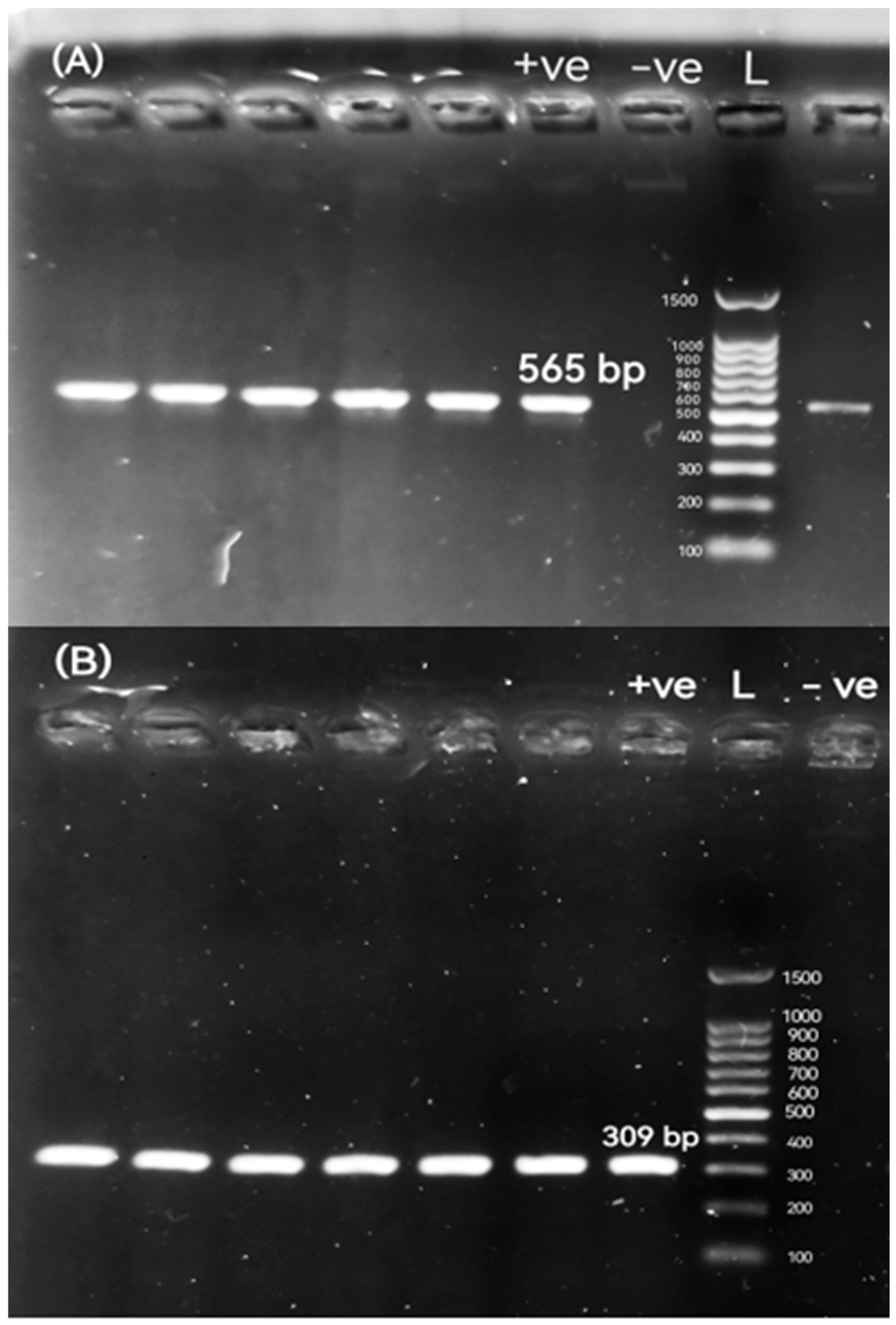

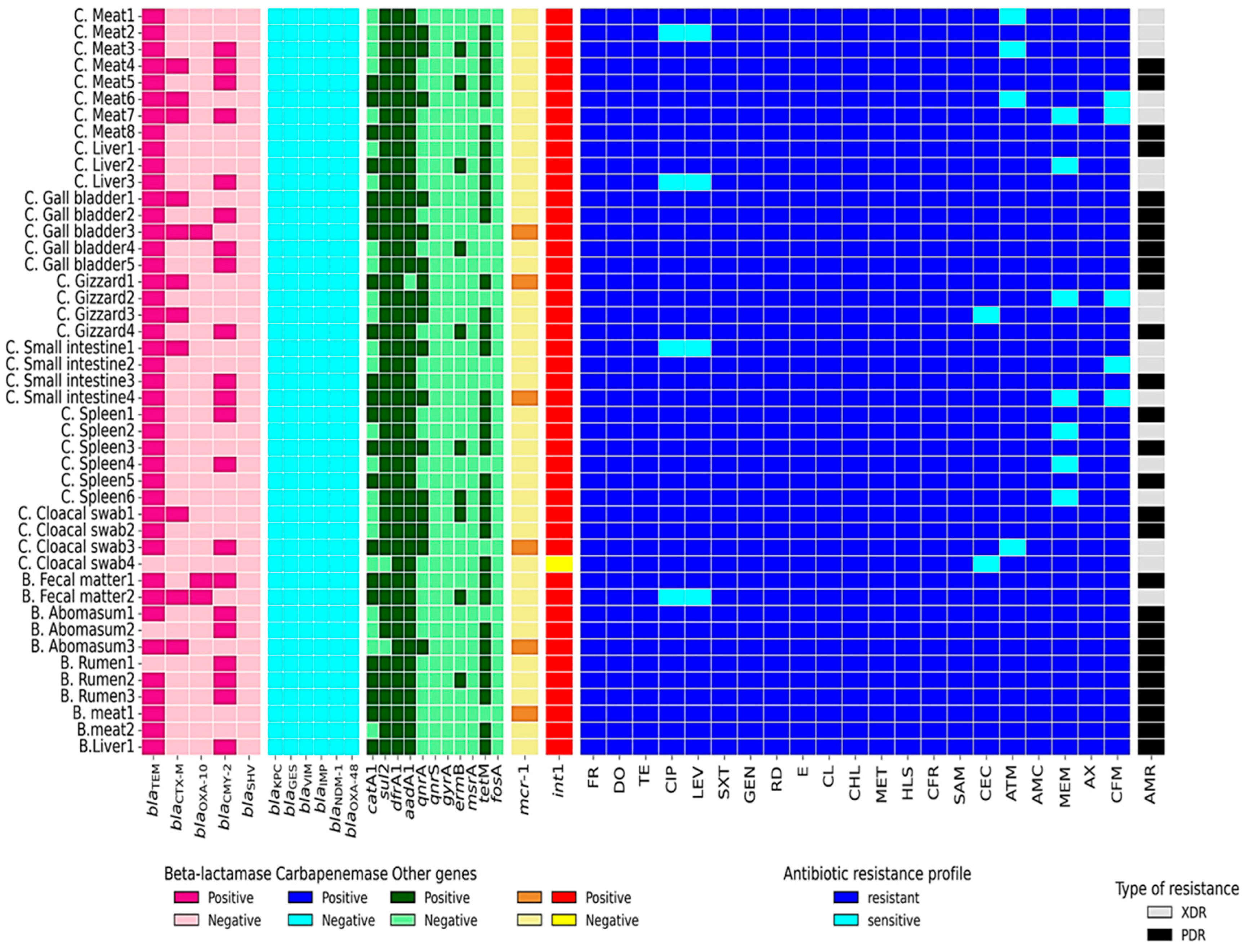

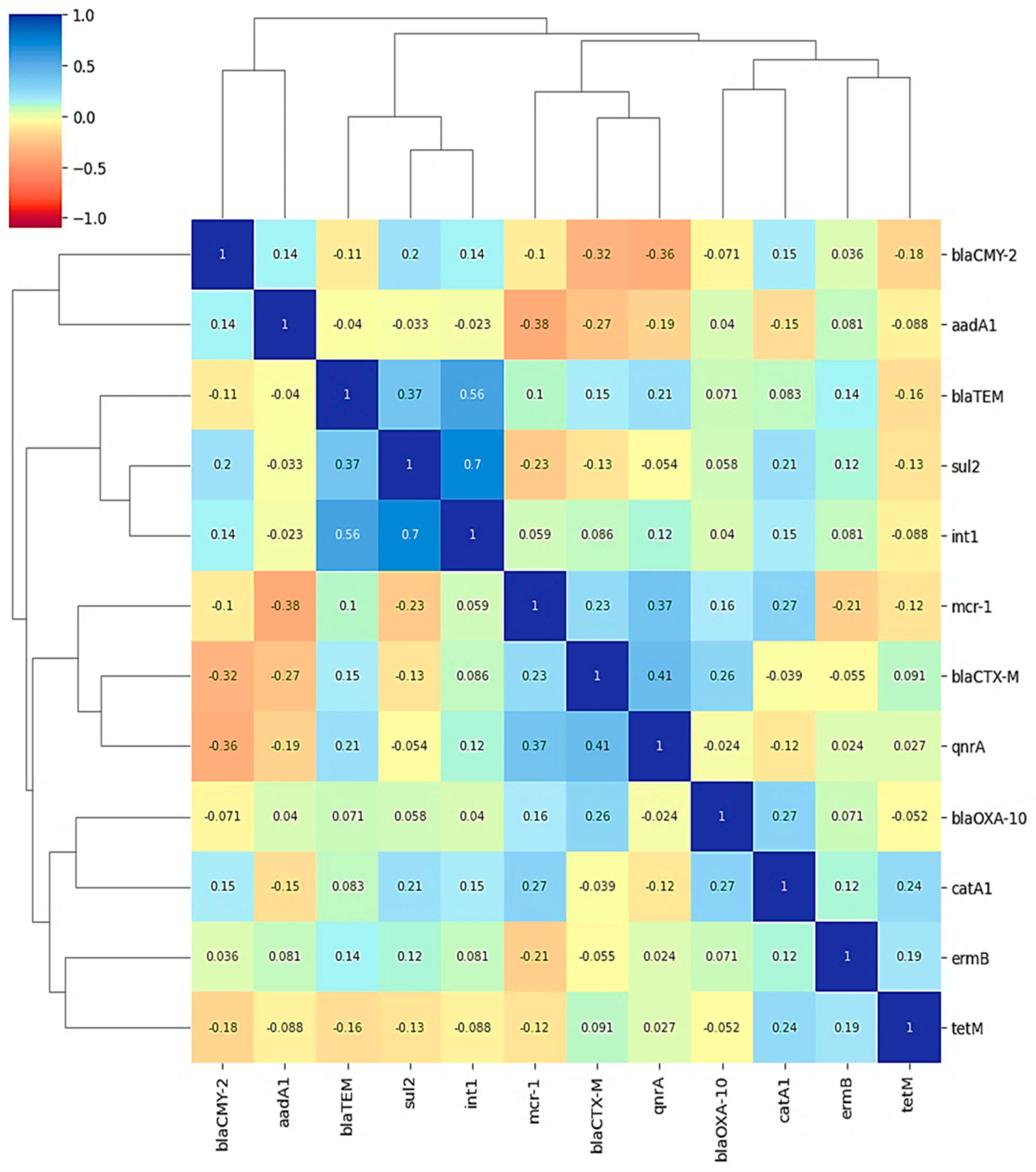
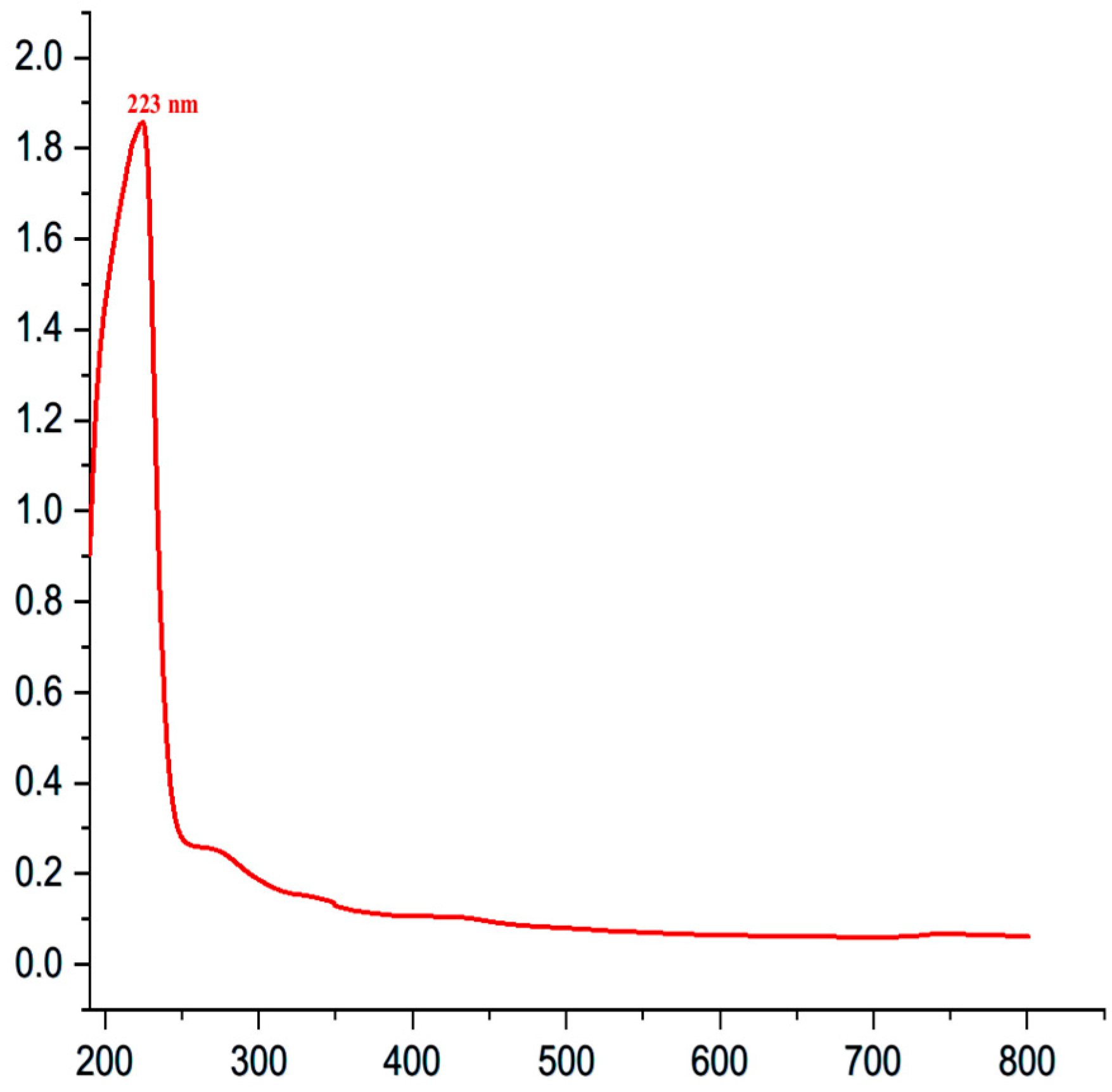
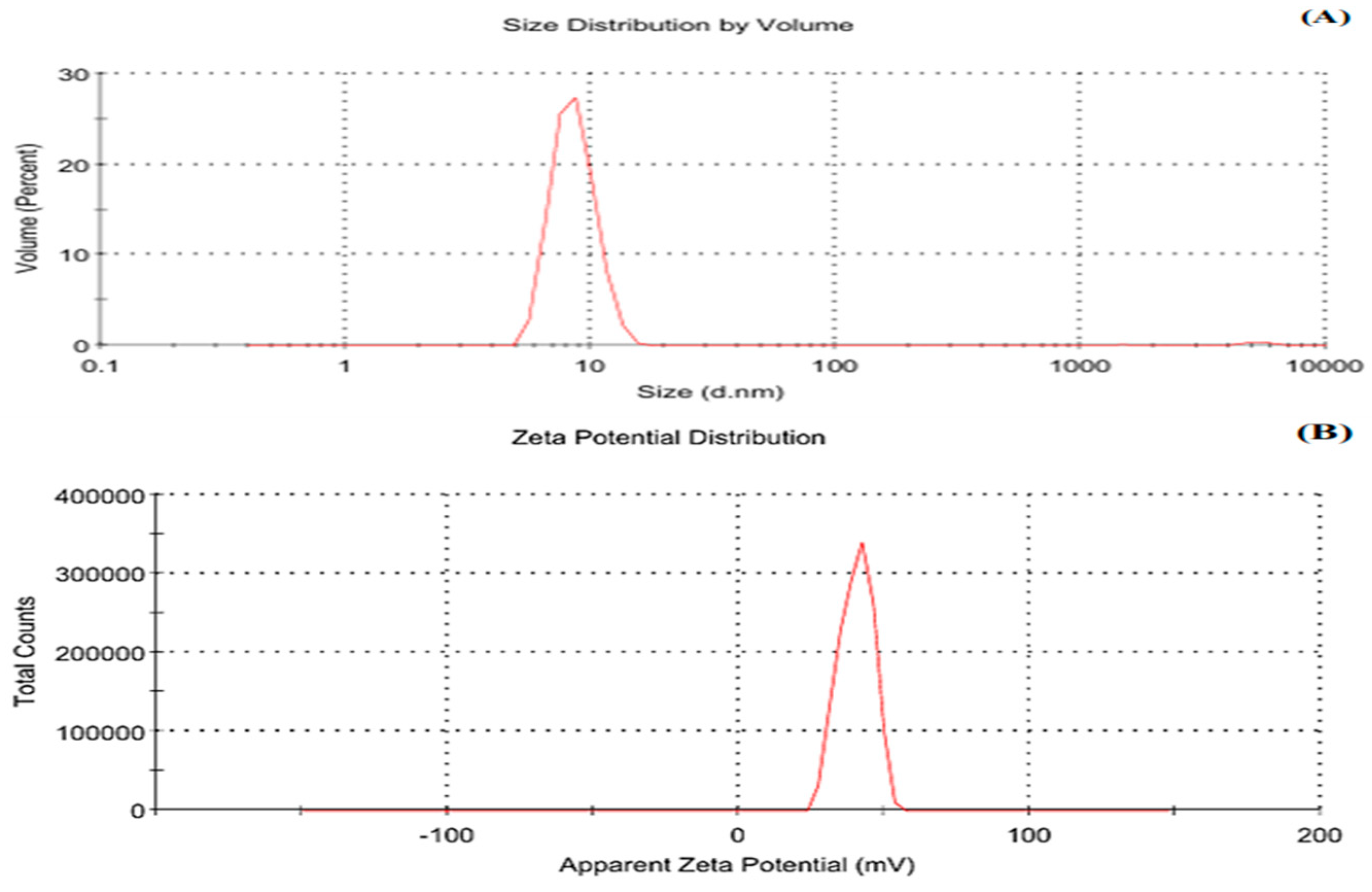
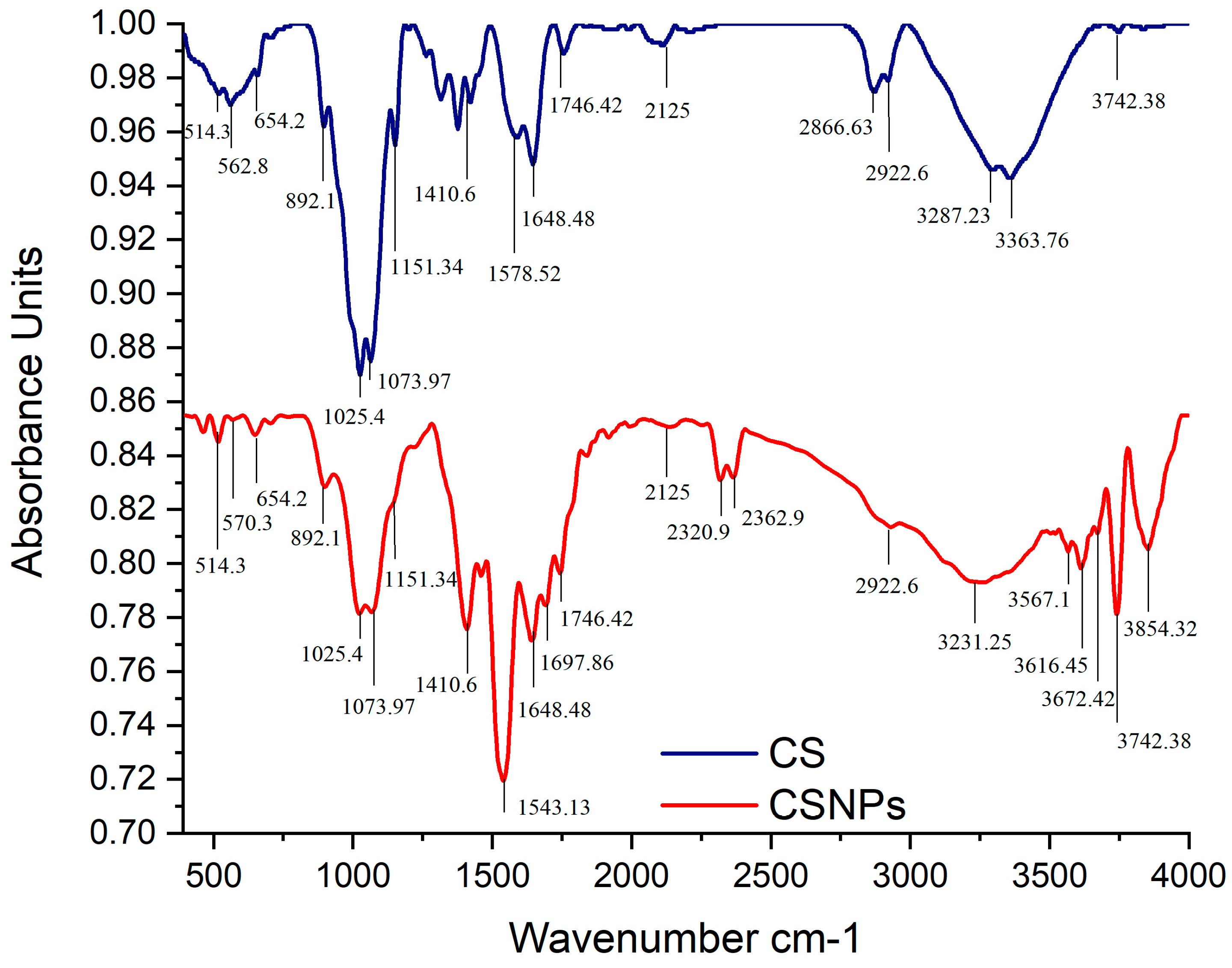

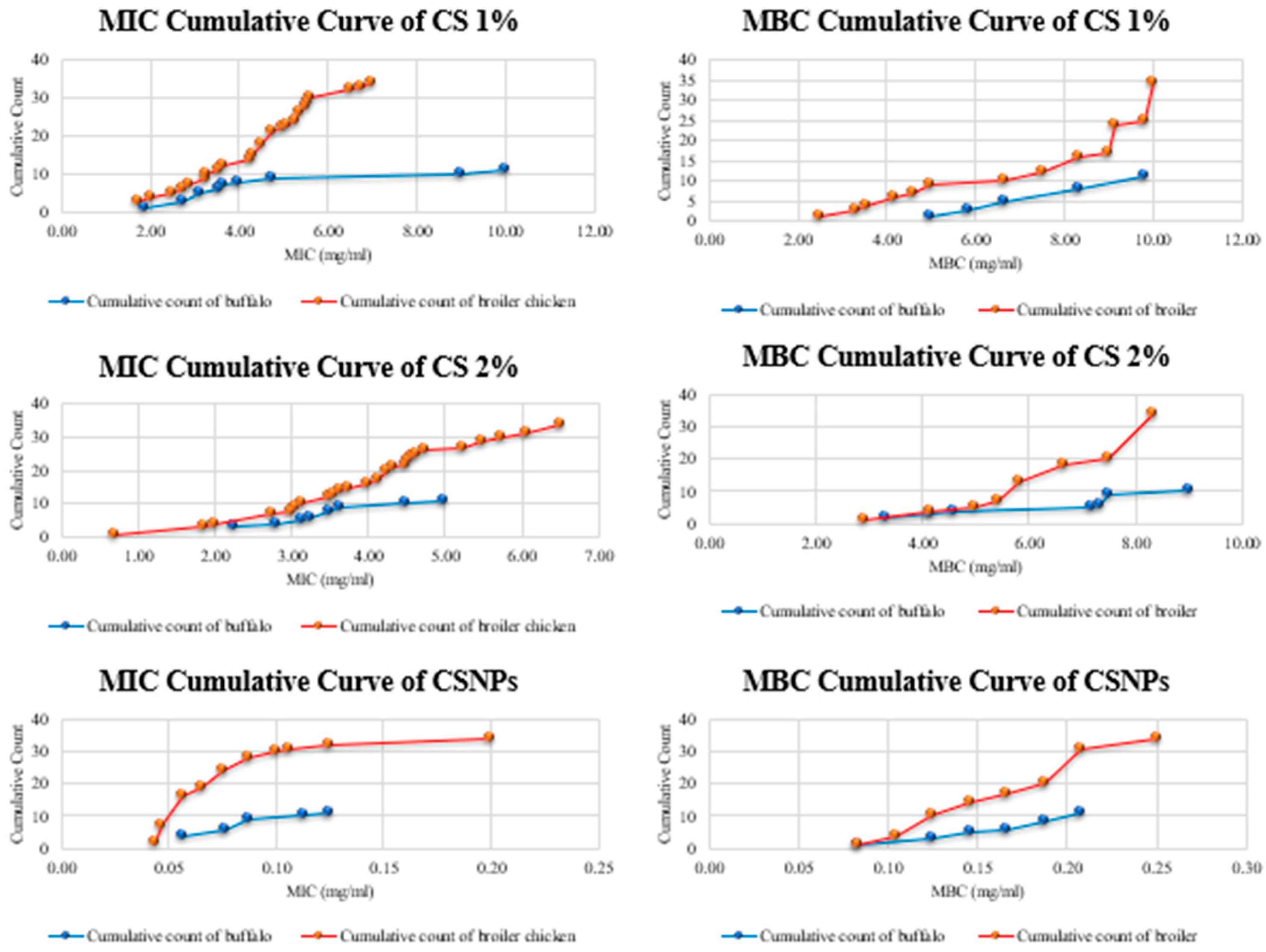

| WHO Classification | Antimicrobial Group | Antimicrobial (Full Name) | Abbreviation | Disk Content (µg) |
|---|---|---|---|---|
| Critically important | Penicillins | Amoxicillin | AMX | 10 |
| Carbapenem | Meropenem | MEM | 10 | |
| Macrolides | Clarithromycin | CL | 15 | |
| Erythromycin | E | 15 | ||
| Aminoglycosides | Gentamicin | GEN | 10 | |
| Streptomycin | HLS | 300 | ||
| Fluoroquinolones | Levofloxacin | LEV | 5 | |
| Ciprofloxacin | CIP | 5 | ||
| Rifampicin | Rifampin | RD | 5 | |
| Cephalosporins 3rd generation | Cefixime | CFM | 5 | |
| Monobactam | Aztreonam | ATM | 30 | |
| Beta lactamase inhibitor | Ampicillin/sulbactam | SAM | 10/10 | |
| Amoxicillin/clavulanic acid | AMC | 20/10 | ||
| Highly important | Tetracyclines | Tetracycline | TE | 30 |
| Doxycycline | DO | 30 | ||
| Phenicol | Chloramphenicol | CHL | 30 | |
| Folate pathway antagonists | Sulfamethoxazole/trimethoprim | SXT | 23.75/1.25 | |
| Cephalosporins, 1st generation | Cefadroxil | CFR | 30 | |
| Cephalosporins, 2nd generation | Cefaclor | CEC | 30 | |
| Important | Nitroimidazoles | Metronidazole | MET | 5 |
| Nitrofurans | Furazolidone | FR | 50 |
| Antimicrobial Class | Target Gene | Sequence (5′ to 3′) | Size (bp) | Annealing Temperature | References |
|---|---|---|---|---|---|
| Beta-lactams | blaCTX-M (ESBL) | F: ATGTGCAGYACCAGTAARGTKATGG R: TGGGTRAARTARGTSACCAGAAYCAGCGG | 593 | duplex PCR by 57 °C | [47] |
| blaTEM | F: ATCAGCAATAAACCAGC R: CCCCGAAGAACGTTTTC | 516 | [48] | ||
| blaOXA-10 | F: TATCGCGTGTCTTTCGAGTA R: TTAGCCACCAATGATGCCC | 760 | 57 °C | [49] | |
| blaSHV | F: AGGATTGACTGCCTTTTTG R: ATTTGCTGATTTCGCTCG | 392 | 57 °C | [48] | |
| ampC (class C) | blaCMY-2 | F: AGCGATCCGGTCACGAAATA R: CCCGTTTTATGCACCCATGA | 695 | 61 °C | [50] |
| Streptomycin | aadA1 | F: TATCCAGCTAAGCGCGAACT R: ATTTGCCGACTACCTTGGTC | 447 | 55 °C | [51] |
| Phenicols | catA1 | F: AGTTGCTCAATGTACCTATAACC R: TTGTAATTCATTAAGCATTCTGCG | 547 | 55 °C | [52] |
| Quinolones | qnrA | F: ATTTCTCACGCCAGGATTTG R: GATCGGCAAAGGTTAGGTCA | 516 | Multiplex PCR by 55 °C | [53] |
| qnrS | F: AGTGATCTCACCTTCACCGC R: CAGGCTGCAATTTTGATACC | 552 | [54] | ||
| Fluoroquinolones | gyrA | F: AGTGTAATTGTTGCCCG R: ATATCGCCATCAACCGA | 470 | [55] | |
| Sulfonamides | sul2 | F: CGGCATCGTCAACATAAACC R: GTGTGCGGATGAAGTCAG | 722 | [56] | |
| Trimethoprim | dfrA1 | F: GGAGTGCCAAAGGTGAACAGC R: GAGGCGAAGTCTTGGGTAAAAAC | 367 | [57] | |
| Tetracyclines | tet(M) | F: GTGGACAAAGGTACAACGAG R: CGGTAAAGTTCGTCACACAC | 406 | 55 °C | [58] |
| Macrolide | ermB | F: GAAAAGGTACTCAACCAAATA R: AGTAACGGTACTTAAATTTGTTTTAC | 636 | 57 °C | [59] |
| msrA | F: GCAAATGGTGTAGGTAAGACAACT R: ATCATGTGATGTAAACAAAAT | 401 | 55 °C | [60] | |
| Integron integrase gene class 1 | int1 | F: GCCTTGCTGTTCTTCTACGG R: GATGCCTGCTTGTTCTACGG | 565 | 57 °C | [61] |
| Fosfomycin | fosA | F: ATCTGTGGGTCTGCCTGTCGT R: ATGCCCGCATAGGGCTTCT | 271 | 55.6 °C | [62] |
| Polymyxins (colistin) | mcr-1 | F: CGGTCAGTCCGTTTGTTC R: CTTGGTCGGTCTGTAGGG | 309 | 57 °C | [63] |
| Beta-lactam (Carbapenemase) | blaOXA-48 (class D) | F: GCTTGACCCTCGATT R: GATTTGCTCCGTGGCCGAAA | 281 | 60 °C | [64] |
| blaIMP (MBLs, class B) | F: TTGACACTCCATTTACDG R: GATYGAGAATTAAGCCACYCT | 139 | 55 °C | ||
| blaKPC (class A) | F: CATTCAAGGGCTTTCTTGCTGC R: ACGACGGCATAGTCATTTGC | 538 | 55 °C | ||
| blaGES (class A) | F: AGTCGGCTAGACCGGAAAG R: TTTGTCCGTGCTCAGGAT | 399 | 57 °C | [65] | |
| blaVIM (MBLs, class B) | F: GATGGTGTTTGGTCGCATA R: CGAATGCGCAGCACCAG | 390 | 60 °C | [66] | |
| blaNDM-1 (MBLs, class B) | F: GGCGGAATGGCTCATCACGA R: CGCAACACAGCCTGACTTTC | 287 | 55 °C | [67] |
| Sample Type | No. of Proteus spp. Isolates (%) | No. of Proteus mirabilis Isolates (%) |
|---|---|---|
| Broiler chickens | ||
| Total no. 50/450 (11.11%) | Total no. 34/50 (68) | |
| Meat | 10/50 (20) | 8/10 (80) |
| Liver | 5/50 (10) | 3/5 (60) |
| Lung | 1/50 (2) | 0 (0) |
| Gall bladder | 8/50 (16) | 5/7 (71.43) |
| Kidney | 2/50 (4) | 0 (0) |
| Gizzard | 8/50 (16) | 4/8 (50) |
| Intestine | 7/50 (14) | 4/7 (57.14) |
| Spleen | 7/50 (14) | 6/7 (85.71) |
| Cloacal swabs | 6/50 (12) | 4/6 (66.67) |
| Buffaloes | ||
| Total no. 27/270 (10) | Total no. 11/27 (40.74) | |
| Muscle | 5/27 (18.52) | 2/5 (40) |
| Liver | 3/27 (11.11) | 1/3 (33.33) |
| Gall bladder | 1/27 (3.7) | 0 (0) |
| Reticulum | 3/27 (11.11) | 0(0) |
| Rumen | 4/27 (14.81) | 3/4 (75) |
| Omasum | 2/27 (7.41) | 0(0) |
| Abomasum | 4/27 (14.81) | 3/4 (75) |
| Small intestine | 2/27 (7.41) | 0 (75) |
| Fecal matter | 4/27 (14.81) | 2/4 (50) |
| Source | Resistance Type | No. of Resistant Isolates | % of Isolates | Antibiotic Classes Resistant | MAR Index Range |
|---|---|---|---|---|---|
| Broiler Chicken | XDR | 17 | 50 | 11–12 | 0.846–0.923 |
| Broiler Chicken | PDR | 17 | 50 | 13 | 1 |
| Buffalo | XDR | 1 | 9.09 | 11 | 0.846 |
| Buffalo | PDR | 10 | 90.91 | 13 | 1 |
| Antimicrobial Resistance Gene | Antibiotic Disk | Resistant Broiler Isolates No. 34 | Resistant Buffalo Isolates No. 11 | Gene-Resistant Broiler Chickens’ Isolates | Gene-Resistant Buffalo Isolates | Broiler Concordance % | Buffalo Chickens’ Concordance % |
|---|---|---|---|---|---|---|---|
| blaTEM | CFR CEC SAM AX CFM AMC ATM | 34 (100%) 32 (94.12%) 34 (100%) 34 (100%) 29 (85.29%) 34 (100%) 30 (88.24%) (85.29–100%) | 11 (100%) 11 (100%) 11 (100%) 11 (100%) 11 (100%) 11 (100%) 11 (100%) (100%) | (33/34) 97.06% | (9/11) 81.82% | 97.06 | 81.82 |
| blaCTX-M | (9/34) 26.47% | (2/11) 18.18% | 26.47 | 18.18 | |||
| blaOXA-10 | (1/34) 2.94% | (2/11) 18.18% | 2.94 | 18.18 | |||
| blaCMY-2 | (14/34) 41.18% | (7/11) 63.64% | 41.18 | 63.64 | |||
| blaSHV | 0 | 0 | 0 | 0 | |||
| blaKPC, blaGES, blaVIM, blaIMP, blaNDM-1, blaOXA-48 | MEM | 27 (79.41%) | 11 (100%) | 0 | 0 | 0 | 0 |
| sul2 | STX | 34 (100%) | 11 (100%) | (33/34) 97.06 | (10/11) 90.91 | 97.06 | 90.91 |
| dfrA1 | STX | 34 (100%) | 11 (100%) | (34/34) 100 | (11/11) 100 | 100 | 100 |
| qnrA | CIP LEV | 31 (91.18%) 31 (91.18%) | 10 (90.91%) 10 (90.91%) | (16/34) 47.06 | (1/11)9.09% | 47.06 | 9.09 |
| qnrS | 0 | 0 | 0 | 0 | |||
| gyrA | 0 | 0 | 0 | 0 | |||
| ermB | CL E | 34 (100%) 34 (100%) | 11 (100%) 11 (100%) | (8/34) 23.53 | (2/11) 18.18 | 23.53 | 18.18 |
| msrA | 0 | 0 | 0 | 0 | |||
| tet(M) | TE DO | 34 (100%) 34 (100%) | 11 (100%) 11 (100%) | (24/34) 70.79 | (9/11) 81.82 | 70.79 | 81.82 |
| aadA1 | HLS | 34 (100%) | 11 (100%) | (33/34) 97.06 | (11/11) 100 | 97.06 | 100 |
| catA1 | CHL | 34 (100%) | 11 (100%) | (15/34) 44.12 | (7/11) 63.64 | 44.12 | 63.64 |
| Inhibition Zone | Broiler (N = 34) | Buffalo (N = 11) | p-Value 2 | ||||||||||
|---|---|---|---|---|---|---|---|---|---|---|---|---|---|
| Median | IQR | Zone Area = (πr2) (mm2) | Fold-Change (Area) | % | p-Value 1 | Median | IQR | Zone Area = (πr2) (mm2) | Fold-Change (Area) | % | p-Value 1 | ||
| CIP (control) | 1.52 | 0.725 | 3.14 | 1 | - | 1.6 | 0.233 | 3.36 | 1 | - | 0.6 | ||
| CS 1% | 1.68 | 0.5 | 1.81 | - | - | <0.001 * | 1.73 | 0.167 | 2 | - | - | 0.017 * | 0.5 |
| CS 2% | 1.88 | 0.383 | 2.21 | - | - | <0.001 * | 1.9 | 0.183 | 2.34 | - | - | <0.001 * | 0.4 |
| CSNPs | 2 | 0.3 | 2.77 | - | - | <0.001 * | 2.07 | 0.1 | 2.80 | - | - | <0.001 * | 0.3 |
| CS 1% + CIP | 2.1 | 0.467 | 3.46 | 1.1 | 10 | <0.001 * | 2.1 | 0.2 | 3.46 | 1.02 | 2 | <0.001 * | 0.7 |
| CS 2% + CIP | 2.37 | 0.567 | 4.40 | 1.4 | 40 | <0.001 * | 2.4 | 0.4 | 4.50 | 1.4 | 40 | <0.001 * | 0.9 |
| CSNPs + CIP | 2.45 | 0.658 | 4.71 | 1.5 | 50 | <0.001 * | 2.6 | 0.383 | 5.30 | 1.58 | 58 | <0.001 * | 0.9 |
| Pairwise Comparisons of Inhibition Zone Measurements | Broiler (N = 34) | Buffalo (N = 11) | |||
|---|---|---|---|---|---|
| Median Difference | p-Value | Median Difference | p-Value | ||
| CSNPs + CIP | CS 2% + CIP | +0.08 | <0.001 * | +0.2 | <0.001 * |
| CSNPs + CIP | CS 1% + CIP | +0.35 | <0.001 * | +0.5 | <0.001 * |
| CSNPs + CIP | CSNPs | +0.57 | <0.001 * | +0.7 | <0.001 * |
| CSNPs + CIP | CS 2% | +0.77 | <0.001 * | +0.87 | <0.001 * |
| CSNPs + CIP | CS 1% | +0.93 | <0.001 * | +1 | <0.001 * |
| CSNPs + CIP | CIP | +0.45 | <0.001 * | +0.53 | <0.001 * |
| CS 2% + CIP | CS 1% + CIP | +0.27 | <0.001 * | +0.3 | <0.001 * |
| CS 2% + CIP | CSNPs | +0.49 | <0.001 * | +0.33 | <0.001 * |
| CS 2% + CIP | CS 2% | +0.69 | <0.001 * | +0.67 | <0.001 * |
| CS 2% + CIP | CS 1% | +0.85 | <0.001 * | +0.8 | <0.001 * |
| CS 2% + CIP | CIP | +0.37 | <0.001 * | +0.33 | <0.001 * |
| CS 1% + CIP | CSNPs | +0.22 | <0.001 * | +0.2 | 0.094 |
| CS 1% + CIP | CS 2% | +0.42 | <0.001 * | +0.37 | <0.001 * |
| CS 1% + CIP | CS 1% | +0.58 | <0.001 * | +0.5 | <0.001 * |
| CS 1% + CIP | CIP | +0.10 | <0.001 * | +0.03 | <0.001 * |
| CSNPs | CS 2% | +0.20 | <0.001 * | +0.17 | <0.001 * |
| CSNPs | CS 1% | +0.36 | <0.001 * | +0.30 | <0.001 * |
| CSNPs | CIP | −0.12 | <0.001 * | −0.17 | <0.001 * |
| CS 2% | CS 1% | +0.16 | <0.001 * | 0.13 | <0.001 * |
| CS 2% | CIP | −0.32 | <0.001 * | −0.34 | <0.001 * |
| CS 1% | CIP | −0.48 | <0.001 * | −0.47 | 0.017 * |
| Results | Broiler (N = 34) | Buffalo (N = 11) | p-Value | ||
|---|---|---|---|---|---|
| Median | IQR | Median | IQR | ||
| CSNPs MIC | 0.0672 | 0.0312 | 0.0813 | 0.025 | 0.283 |
| CSNPs MBC | 0.177 | 0.0833 | 0.167 | 0.0625 | 0.61 |
| MBC/MIC Ratio | 2.63 | - | 2.05 | - | - |
| CS 2% MIC | 4.19 | 1.64 | 3.25 | 0.906 | 0.086 |
| CS 2% MBC | 6.67 | 2.5 | 7.33 | 3.13 | 0.74 |
| MBC/MIC Ratio | 1.59 | - | 2.26 | - | - |
| CS 1% MIC | 4.5 | 2.12 | 3.56 | 1.44 | 0.328 |
| CS 1% MBC | 9.08 | 4.54 | 8.33 | 2.83 | 0.59 |
| MBC/MIC Ratio | 2.2 | - | 2.34 | - | - |
| Source | Agents (mg/mL) | Minimum | Q1 | MIC50 | Q3 | MIC90 | IQR | Maximum |
|---|---|---|---|---|---|---|---|---|
| MIC of buffalo | CS 1% | 1.88 | 2.75 | 3.56 | 4.75 | 9 | 2 | 10 |
| CS 2% | 2.25 | 2.25 | 3.25 | 3.63 | 4.5 | 1.38 | 5 | |
| CSNPs | 0.06 | 0.06 | 0.08 | 0.09 | 0.11 | 0.03 | 0.13 | |
| MIC of broiler chicken | CS 1% | 1.75 | 3.25 | 4.5 | 5.38 | 6.5 | 2.13 | 7 |
| CS 2% | 0.69 | 3.06 | 4.13 | 4.75 | 6.06 | 1.69 | 6.5 | |
| CSNPs | 0.04 | 0.06 | 0.07 | 0.09 | 0.11 | 0.03 | 0.2 | |
| Minimum | Q1 | MBC50 | Q3 | MBC90 | IQR | Maximum | ||
| MBC of buffalo | CS 1% | 5 | 5.83 | 8.33 | 9.83 | 9.83 | 4 | 9.83 |
| CS 2% | 3.33 | 4.17 | 7.33 | 7.50 | 9 | 3.33 | 9 | |
| CSNPs | 0.08 | 0.13 | 0.17 | 0.21 | 0.21 | 0.08 | 0.21 | |
| MBC of broiler chicken | CS 1% | 2.5 | 5 | 9 | 10 | 10 | 5 | 10 |
| CS 2% | 2.92 | 5.83 | 6.67 | 8.33 | 8.33 | 2.5 | 8.33 | |
| CSNPs | 0.08 | 0.13 | 0.17 | 0.21 | 0.21 | 0.08 | 0.25 | |
| Pairwise Comparisons | Median Difference | p-Value |
|---|---|---|
| MIC comparisons in broiler | ||
| CSNPs vs. CS 2% | −4.1203 | <0.001 * |
| CSNPs vs. CS 1% | −4.4328 | <0.001 * |
| CS 2% vs. CS 1% | −0.3125 | 0.468 |
| MIC Comparisons in buffalo | ||
| CSNPs vs. CS 2% | −3.1687 | <0.001 * |
| CSNPs vs. CS 1% | −3.4812 | <0.001 * |
| CS 2% vs. CS 1% | −0.3125 | 0.001 * |
| MBC Comparisons in broiler | ||
| CSNPs vs. CS 2% | −6.5 | <0.001 * |
| CSNPs vs. CS 1% | −8.9 | <0.001 * |
| CS 2% vs. CS 1% | −2.4 | 0.003 * |
| MBC Comparisons in buffalo | ||
| CSNPs vs. CS 2% | −7.16 | <0.001 * |
| CSNPs vs. CS 1% | −8.16 | <0.001 * |
| CS 2% vs. CS 1% | −1 | 0.001 * |
| Swarming Motility Results | Broiler (N = 34) | Buffalo (N = 11) | p-Value | ||
|---|---|---|---|---|---|
| Median | IQR | Median | IQR | ||
| Control | 4.27 | 1.64 | 4.27 | 1.4 | 0.46 |
| CS 2% | 2.33 | 0.69 | 2.2 | 0.38 | 0.74 |
| CSNPs | 2.20 | 0.55 | 2.07 | 0.35 | 0.67 |
| Pairwise Comparisons | Median Difference | Reduction % | p-Value | |
|---|---|---|---|---|
| Pairwise comparisons of swarming motility in broiler | ||||
| Control | CS 2٪ | +1.94 | 45.4 | <0.001 * |
| Control | CSNPs | +2.07 | 48.4 | <0.001 * |
| CSNPs | CS 2٪ | +0.13 | <0.001 * | |
| Pairwise comparisons of swarming motility in buffalo | ||||
| Control | CS 2٪ | +2.07 | 48.4 | <0.001 * |
| Control | CSNPs | +2.2 | 51.5 | <0.001 * |
| CSNPs | CS 2٪ | +0.13 | <0.001 * | |
Disclaimer/Publisher’s Note: The statements, opinions and data contained in all publications are solely those of the individual author(s) and contributor(s) and not of MDPI and/or the editor(s). MDPI and/or the editor(s) disclaim responsibility for any injury to people or property resulting from any ideas, methods, instructions or products referred to in the content. |
© 2025 by the authors. Licensee MDPI, Basel, Switzerland. This article is an open access article distributed under the terms and conditions of the Creative Commons Attribution (CC BY) license (https://creativecommons.org/licenses/by/4.0/).
Share and Cite
Hasona, I.F.; Awad, A.; Younis, G.; Mohamed, W.F. Effectiveness of Chitosan and Its Nanoparticles Against ampC- and ESBL-Producing Pan-Drug-Resistant Proteus mirabilis in Egyptian Livestock. Pathogens 2025, 14, 1176. https://doi.org/10.3390/pathogens14111176
Hasona IF, Awad A, Younis G, Mohamed WF. Effectiveness of Chitosan and Its Nanoparticles Against ampC- and ESBL-Producing Pan-Drug-Resistant Proteus mirabilis in Egyptian Livestock. Pathogens. 2025; 14(11):1176. https://doi.org/10.3390/pathogens14111176
Chicago/Turabian StyleHasona, Ibtisam Faeq, Amal Awad, Gamal Younis, and Wafaa Farouk Mohamed. 2025. "Effectiveness of Chitosan and Its Nanoparticles Against ampC- and ESBL-Producing Pan-Drug-Resistant Proteus mirabilis in Egyptian Livestock" Pathogens 14, no. 11: 1176. https://doi.org/10.3390/pathogens14111176
APA StyleHasona, I. F., Awad, A., Younis, G., & Mohamed, W. F. (2025). Effectiveness of Chitosan and Its Nanoparticles Against ampC- and ESBL-Producing Pan-Drug-Resistant Proteus mirabilis in Egyptian Livestock. Pathogens, 14(11), 1176. https://doi.org/10.3390/pathogens14111176







